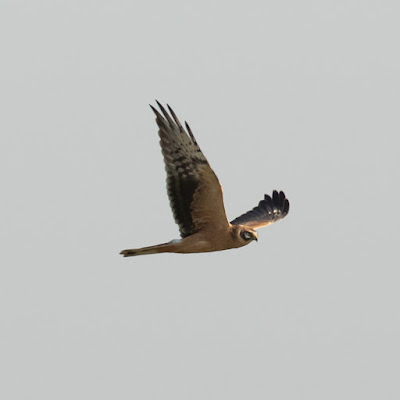 |
| Bewick's Swans (c) Jackie Newcombe |
Until the first frosts at the very end of the month November was uncharacteristically warm and wet. The frequent heavy rain has added to the lying water and scrapes and ditches are now full and some fields, especially out on the adjacent MOD land, are already flooding up.
 |
| Goosander courtesy of Paul Wyeth. |
Water levels across the reserve are already fifty centimetres higher than they were at the same time last year.
 |
| Wigeon and Mallard (c) Bark |
The Flood Field on the Oddington side of the moor is already holding a lot of water and this is attracting large numbers of wildfowl. Teal, Wigeon and Shoveller numbers recorded on the latest WEBS survey are higher than those usually seen at this stage of the winter. We have also recorded over forty Pintail which usually appear in the middle and later winter periods.
 |
| Meadow Pipit and Pied Wagtail on ice at the Hide (c) Bark |
The winter seed feeding for seed eaters has started beside the Wetlands Watch and is already attracting good numbers of Linnets, Chaffinches and Reed Buntings.
 |
| Chaffinch Linnet and Reed Bunting by the hide (c) Bark |
As the natural supplies of small seeds out in the wider countryside diminishes, we will find even larger numbers of birds coming in to feed. In previous winters Bramblings, Redpolls and Yellow Hammers have been regular visitors along with a scattering of Goldfinches and Bullfinches.
 |
| Yellowhammer (c) Bark |
We were treated to a visit by two Bewick’s Swans on the last weekend of the month. The birds were on passage and left before dark, heading westward.
 |
| Bewick's Swans (c) Pete Roby |
They were the first Bewick’s to visit us since February 2011, which sadly reflects their increasing rarity. They left heading west and one of them was recognised at Slimbridge the next morning, as “Bruton”. Bewick’s swans have unique bill patterns that make them identifiable as individuals.
 |
| Mute Swans (c) Bark |
We tend not to pay too much attention to our resident Mute Swans, which is a pity as they are both beautiful and display a host of fascinating behaviours. A pair brought their seven small cygnets to the reedy bank in front of the second screen in the spring and spent a lot of time in May and June resting up there when not out on the water.
 |
| Cygnets in June by second screen (c) Bark |
It has good to watch them develop, although the original seven cygnets are now reduced to five, they are now fully fledged.
 |
| Marching across Greenaway's in September (c) Bark |
They are still sticking together as a group but will soon disperse and eventually be driven off by the adults.
 |
| In front of the first screen last week (c) Bark |
The Starling roost is underway but often fails to offer the spectacle that it once did. There are significantly large numbers of birds coming into the roost, but they do not always perform the expected display.
 |
| Warming up after a cold night (c) Bark |
As soon as we have significant frosts and the water under the reedbed freezes solid the Starlings will move, to somewhere that does not make them vulnerable to predation from below. The large number of birds present attracts predators.
 |
| Sparrowhawk over the reedbed (c) Bark |
This year there is a ring-tailed Hen Harrier being seen, as well as three Marsh Harriers, several Sparrowhawks and at least two regular Peregrines.
 |
| Reed Bunting munching reeds (c) Bark |
If travelling down to see the Starlings try to avoid the weekends and if possible, car-share. After the heavy rains the paths out to the viewpoints are very muddy indeed, which is further compounded by the very heavy footfall at this time of year.
 |
| The low sun in the mornings can light up the trees. |
Lapwing and Golden Plover numbers are steadily increasing, as the wider countryside dries out and the moor remains wet, so it will attract even more of them.
 |
| Lapwings over the screen (c) Bark |
There have been very large numbers of Fieldfares feeding in the hedges and out on the fields. They seem to outnumber the Redwings by about five to one.
 |
| Fieldfare by the hide (c) Bark |
There is still plenty of fruit on the Hawthorn bushes and lots of rosehips in the hedgerows. We must hope that there are still some berries available should the Waxwings, that are already being seen in adjacent counties, come south to us!
 |
| Frosty goldfinch (c) Bark |


















































